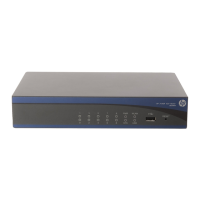53
Step Command Remarks
7. Configure the T1 operating
mode.
• Specify the unframed mode:
t1 t1-number unframed
• Specify the framed mode and
bundle timeslots:
a. (Optional.) undo t1
t1-number unframed
b. t1 t1-number channel-set
set-number timeslot-list
range [ speed { 56k |
64k } ]
By default, a T1 channel operates
in framed mode and is not
channelized.
When you place a T1 channel in
unframed mode, the system
automatically creates a
1.544-Mbps serial interface.
When you bundle timeslots on a T1
channel, the system automatically
creates a serial interface for the
bundle. The rate of the serial
interface is identical to timeslot rate
(54 kbps or 64 kbps) x number of
bundled timeslots.
8. (Optional.) Shut down the
specified T1 channel.
t1 t1-number shutdown By default, a T1 channel is up.
Displaying and maintaining CPOS interfaces
Execute display commands in any view and reset commands in user view.
Task Command
Display CPOS interface status information. display controller cpos [ cpos-number ]
Display status information for an E1 channel on a
CPOS interface.
display controller cpos cpos-number e1 e1-number
Display status information for a T1 channel on a CPOS
interface.
display controller cpos cpos-number t1 t1-number
Display information about an E1/T1 serial interface.
display interface serial
interface-number/channel-number:set-number
Clear statistics for a CPOS interface. reset counters controller cpos interface-number
For more information about the display interface serial command, see Interface Command Reference.
CPOS-E1 interface configuration example
Network requirements
As shown in Figure 5, branch nodes Router B through Router H are uplinked to the central node Router
A through E1 links. Router A aggregate these E1 links with a CPOS interface.
Add one more E1 link on Router B to expand its capacity. In addition, bind the two E1 links through an
MP-group interface.

